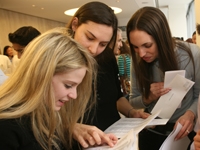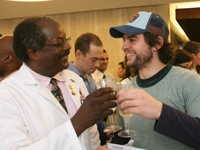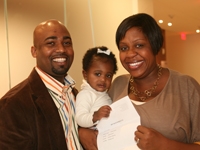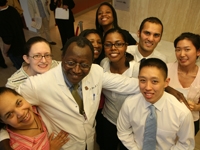Click here for a slideshow of Match Day 2007.

Class of 2007 students Marnie Nussbaum, Kathleen Forcier and Katharine Lampen.
Corners throughout the Great Hall at the Weill Greenberg Center were lit up by the glow of cell phones just after noon on March 15, as fourth-year medical students at Weill Cornell Medical College called their family and friends with good news: all 92 of them would have jobs next year, and yes, after four rigorous years at Weill Cornell, they would be at some of the most prestigious medical institutions in the country.
For more than 15,000 students across the country, "Match Day" is the moment when medical school seniors first learn where they will be spending their years of residency training following graduation. At exactly noon, students ceremoniously open envelopes holding the fate of their next four years.
The match process begins as students apply to as many as 20 residency programs throughout the U.S., who select qualified students to meet for an informational interview. Following that meeting, both sides rank each other, with the most accomplished seniors "matching" with the top institutions.
"This is one of those days that we always remember," said Dr. Antonio M. Gotto Jr., dean of Weill Cornell Medical College. "We have another outstanding round of students and we are proud of all of them."
This year, 78 percent of Weill Cornell graduates matched to a position at one of the top 50 medical institutions as ranked by U.S. News & World Report in 2006. Mirroring a national trend, more Weill Cornell graduates applied for—and successfully matched in—the nine most competitive subspecialties, which include dermatology, emergency medicine, neurology, neurological surgery, ophthalmology, otolaryngology, orthopedics, radiology and urology.

A toast to Gonzalo Perez del Puerto from Dr. Carlyle Harvey Miller.
Although the process has become extremely competitive—with grades, extracurricular activities, and independent research experience all boosting students' chances of a prestigious match—one aspect has not changed since the National Residency Matching Program began 55 years ago: It is an individual relationship between an institution and a student, and no statistic can quantify exactly what makes a "good match."
"It's a very individual definition of success," said Dr. Carol Storey-Johnson, senior associate dean for education, moments before the students were allowed to rush forward and open their "match" envelopes. "We know where our students are going and we know that Weill Cornell has done well, but 'match success' is an intricate and complex phenomenon to describe."

Ronald Charles celebrates his match in general surgery at the Cleveland Clinic with his family.
Although students can apply to more than two dozen different kinds of programs and specific specialties, medicine often breaks down into broader categories, such as those positions geared toward the technically inclined (surgery or positions that involve dialysis or catheterization, for instance) or those requiring more patient interaction (psychiatry and family practice), said Dr. Storey-Johnson.

All smiles for Dr. Estomih Mtui and Class of 2007 students (from left) Katisha Baldwin, Karen Hollingsworth, Vanneta Hyatt, Tanya Johns, Terry-Ann Chambers, Neil Shah, Jeffrey Loh and Stella Maeng.
As for the chosen institution's quality, students may weigh factors like reputation or location, but they also include intangible factors. "Institutions want the most qualified students and students want to go where they'll get the best possible training, but there are a lot of 'gut' feelings in a final match list"," said Dr. Peter Marzuk, Weill Cornell's associate dean for curricular affairs, adding that he has known many top students who ranked the best programs lower on their list because of a feeling about that particular institution.
To make these decisions, students are provided with a faculty adviser at Weill Cornell from their chosen field of interest, but many also rely on informal networks comprised of upperclassmen, deans, trusted faculty and the residents they meet while doing subinternships in hospitals around New York City.
Laura Libby, a fourth-year student from New York who applied to 17 programs and ultimately matched to St. Vincent's Hospital in Manhattan, said her parents—both doctors—as well as residents at NewYork-Presbyterian/Weill Cornell provided some of her best counsel. But ultimately her final decision came down to an impression, not statistics or rankings: "You get a feel for them and you might get a feel back from them—and I got that feel at St. Vincent's."
Photography by Richard Lobell.

